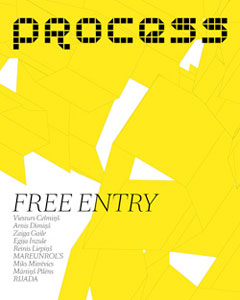
What do the Day-Care Centre for the Homeless and Underprivileged on Rīga’s Katoļu iela, the artists’ quarter at Andrejsala, the Majori Primary School Sports Ground and the Pārventa Library have in common? They are all featured in Process, a recently released book on contemporary architecture as examples of innovative design that can be found in Latvia today.
The book is the second in a series of two so far. The first book, Kā rodas laba arhitektūra?, was released in 2008. The aim of both is to give architects and designers a platform to express views on Latvian design trends and their place in the world today.
Process is a very apt title for this book. It doesn’t aim to boast the achievements of the young and talented players in the field. Emphasis is on the thought process involved in designing a project. This is the internal dialogue of the architect or designer trying to fuse their own aesthetic taste with their interpretation of a Latvian style and the functionality of the building, bearing in mind the building regulations governing the object.
Interviews with various high-profile architects—such as Arnis Dimiņš (involved in designing the Dzintari Forest Park in Jūrmala), Zaiga Gaile (renowned for the transformation of the old wooden buildings in Ķīpsala), and Roland Pēterkops and Mārīte Mastiņa (the fashion designers that make up the firm Mareunrols)—are a brave and successful attempt to delve into the designers’ psyche. By discovering the sources of inspiration for the works of these designers and their view of Latvia’s place in the design world, the book has also prompted an analysis of the direction design is heading. Reflection on the concept of a uniquely Latvian style of design—and whether such a concept actually exists—makes this book a serious and critical, but at the same time easily digestible, look at contemporary design trends in Latvia in the past decade.
The showcased designers are mostly young and energetic professionals who have completed some of their studies abroad and, therefore, have had much more interaction with their contemporaries in other countries than architects and other designers had in the first decade since the fall of the Soviet Union. They have set up their own firms with their own unique sense of style. One obstacle stressed in interviews in both books is the corruption in the government tender process that should be addressed sooner rather than later.
The book also illustrates the effects the economic crisis has had on small businesses, which has resulted in the trend to cooperate with others and to form creative “enclaves” in various places throughout the city. Andrejsala, which has for a few years been the up-and-coming artists’ quarter in Rīga, has now been joined by the Spīķeri area next to the Central Market, Kalnciema kvartāls, and the artists’ territory now slowly finding its place in the grounds of the former VEF electronics factory complex. The appearance of these areas and events organised at these quarters are no longer merely individual attempts at being original in a world of franchises and copy-cat styles, but a collaborative effort by like-minded energetic and creative professionals to find a common physical space to give the fruits of their imagination a home.
A noteworthy section for the budding young designer are the last two pages of the book, featuring interviews with students at internationally acclaimed design schools. This kind of first-hand insight is always good to find.
One shortcoming, however, is the lack of an English translation in full. While some articles are briefly summarized, a full translation of the book would take this excellent showcasing of design talent in Latvia past its borders.
Books such as this are essential in applauding the efforts and achievements of our architects and designers and showing that Latvian artists are an extremely talented bunch. They have the education and often the contacts (the result of studies abroad and many other opportunities for regular interaction), they just need to think outside the square, take a risk, work together with others and not compromise on their vision. The rest will come, once the wheels are set in motion.
Details
Process
Ieva Zībārte, editor
Rīga: Arhitektūras veicināšanas fonds, 2009
ISBN 978-9984-39-902-7
© 1995-2025 Latvians Online
Please contact us for editorial queries, or for permission to republish material. Disclaimer: The content of Web sites to which Latvians Online provides links does not necessarily reflect the opinion of Latvians Online, its staff or its sponsors.




